Subdued house price rises in Malaysia
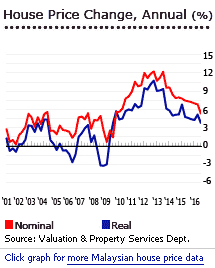 House prices in Malaysia have slowed. In Q3 2016, Malaysia's national house price index rose by 5.36% y-o-y (3.81% inflation-adjusted), slightly lower than the 7.35% y-o-y (4.61% inflation-adjusted) price increase during the same period last year. This was the lowest increase since Q3 2009, based on figures from the Valuation and Property Services Department (JPPH).
House prices in Malaysia have slowed. In Q3 2016, Malaysia's national house price index rose by 5.36% y-o-y (3.81% inflation-adjusted), slightly lower than the 7.35% y-o-y (4.61% inflation-adjusted) price increase during the same period last year. This was the lowest increase since Q3 2009, based on figures from the Valuation and Property Services Department (JPPH).
The national average house price was MYR 334,736 (US$ 75,390.82) in Q3 2016.
The state of Kedah had the highest annual price increase with an 8.8% increase (7.2% inflation-adjusted) during the year to end-Q3 2016. It was followed by Selangor (7.5%), Negeri Sembilan (6.8%), Johor (5.5%), Melaka (5.5%), and Kuala Lumpur (5.1%).
Other states saw moderate house price hikes including Pahang (4.2%), Sarawak (3.6%), Pulau Pinang (3.4%), Terengganu (3%), and Perak (2.5%). House prices in Perlis and Sabah remained unchanged from the previous year. On the other hand, house prices in the state of Kelantan slightly fell by 0.4% (-1.86% inflation-adjusted) during the year to Q3 2016.
The most expensive housing in Malaysia can be found in Kuala Lumpur, with house prices averaging around MYR 772,126 (US$ 173,902) in Q3 2016. Perlis, on the other hand, had the cheapest housing, with an average price of MYR 153,472 (US$ 34,566).
By property type:
- Terraced house average prices rose by 5.6% (4% inflation-adjusted) to MYR 299,012 (US$ 67,345) during the year to Q3 2016.
- High-rise residential properties' average price rose by 6.6% y-o-y (5.1% inflation-adjusted) to MYR 320,782 (US$ 72,248).
- Detached house average prices were up by 3.7% y-o-y (2.2% inflation-adjusted) to MYR 560,987 (US$ 126,348).
- Semi-detached house average prices increased by 5% y-o-y (3.5% inflation-adjusted) to MYR 500,943 (US$ 112,825).
The housing market is expected to continue slow growth in 2017, due to concerns about the slowing economy and the ringgit's weak performance, among others.
"This year (2016) has been a subdued year and we expect the same in 2017," says Knight Frank Malaysia's Managing Director, Sarkunan Subramaniam. "Developers will face lower demand whilst implementing strategies to attract and improve sales to counteract the lower consumer demand due to the current state of the economy.
"On the investment front, vendors have more realistic expectations and purchasers are looking for bargains, therefore we expect to see more sales activity. We anticipate transactions in commercial properties and investment properties to be priced 10% to 20% below perceived market value with realistic and increased yields," Subramaniam added.
The stamp duty rate for properties worth more than MYR 1 million (US$ 225,759) will be raised from 3% to 4% starting January 1, 2018. While this is expected to reduce demand, Knight Frank noted that this might actually "boost sales of million ringgit homes before 2018".
House prices still below Asian crisis levels
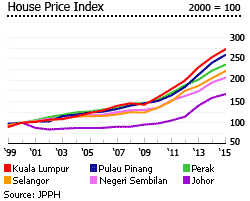
Amazingly, house prices in Malaysia are still below pre-Asian Crisis 1997 levels, in inflation-adjusted terms. They rose rapidly in the early 1990s in two particularly dramatic surges – in 1991 house prices rose 25.5% (20.3% in real terms), and in 1995 they rose 18.4% (14.4% in real terms).
After the Asian Crisis, prices of luxury detached Kuala Lumpur houses then slumped 39% between 1997 and 1999. However, since then Kuala Lumpur's house prices have significantly outperformed the rest of the country, especially after the economic downturn of 2008-2009, when the property market was revitalized with the help of the Greater Kuala Lumpur Plan, targeting developing key locations, including the latest “The MRT Project”. From 2005 to 2014, Kuala Lumpur house prices surged by almost 107% (64% inflation-adjusted).
In contrast national price rises have been more muted. From 2005 to 2014, Malaysia’s house prices rose by 82.5% (44.9% inflation-adjusted).
In 2015, house prices in Kuala Lumpur rose by 7.38% (5.16% inflation-adjusted), while nationwide house prices rose by 7.44% (5.23% inflation-adjusted).
Declining residential property transactions
In Q3 2016, the total number of residential property transactions fell by 13.91% to 49,640 units, or 11.96% by value, from a year earlier, according to the Valuation and Property Services Department (JPPH). Residential transactions accounted for 64.9% of all property transactions in Q3 2016.
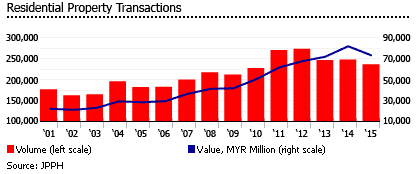
In terms of value, residential property transactions dropped by 10.47% in 2015, following strong increases of 13.88% in 2014, and 6.34% in 2013.
Residential construction falling
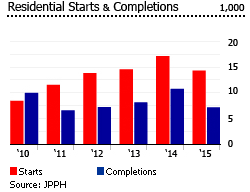
New residential launches fell by 73.6% to 10,655 units during the year to H1 2016, mainly due to the "hold-back sentiment" amongst developers, caused by the softening of the property market activities in the first half of 2016. Major states, particularly Kuala Lumpur, Selangor, Johor, and Pulau Pinang saw huge cutbacks in the number of new launches, ranging from 67.5% up to 93.9%, according on to the JPPH.
New planned supply in the first half of 2016 declined by 2.9% to 576,101 units from the same period last year.
Housing starts dropped by 16.8% y-o-y to 60,378 units in H1 2016, while housing completions plunged by 41.1% to 24,717 units over the same period, according to JPPH.
Malaysia had a total residential stock of almost 4.91 million units in September 2016, according to JPPH, 28% in Selangor, 15% in Johor, 9% in Perak, and 9% in Kuala Lumpur.
Expansion of mortgage market continues; slight drop of loan applications in H1 2016
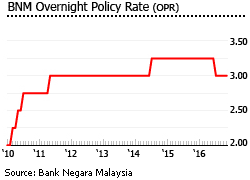
The Overnight Policy Rate (OPR) was reduced to 3% in July 2016. Total outstanding housing loans increased by 8.01% to MYR 447.71 billion (US$ 100.54 billion) In November 2016 from the same period last year, according to Bank Negara Malaysia (BNM), causing the mortgage market to expand to around 36.2% of GDP in 2015, up from 34% of GDP in 2014, 18.9% in 2004, and 13.1% in 1996.
Despite this, loan rejection rates in Malaysia remain high at 59%, adversely impacting the residential property market, according to the country’s Real Estate and Housing Developers Association (REHDA). The amount of loan approvals for purchase of residential property from January to July 2016, was MYR 48.464 billion (US$ 10.92 billion), 21% lower than the loan approvals in the same period in the previous year.
To make home-buying possible for those on low incomes and young people, the Malaysia People’s Housing (PR1MA) Bill 2011 was launched in July 2011, causing developers to switch from high-end developments to mid-range, to lure first time buyers with easier financing and reduced stamp duty for houses below MYR 400,000. Borrowers with a monthly income up to MYR 7,000 per month qualify for the scheme.
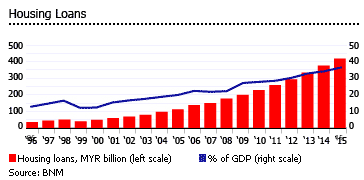
A new end-financing scheme for PR1MA houses was implemented on January 1, 2017 to make financing more accessible to homebuyers, with total loan of up to 100%.
The 2017 budget also raised stamp duty exemption from the current 50% to 100% on instruments of transfer and housing loan instruments. According to the Real Estate and Housing Developers Association (REHDA), the exemption was applicable only to houses worth up to MYR 300,000 (US$ 67,728) for first time buyers, and will be implemented between January 1, 2017 and December 31, 2018. In contrast, the stamp duty on instruments of transfer of properties worth MYR 1 million (US$ 225,759) will be raised to 4%, from the current rate of 3%, starting January 1, 2018.
Tighter lending and anti-speculation measures
Bank Negara Malaysia (BNM) introduced stricter lending guidelines on January 1, 2012, requiring mortgage eligibility assessments to be based on net income, considering:
- Statutory deductions for tax;
- Employees Provident Fund (EPF) contributions, and;
- All other debt obligations.
In July 2013, BNM reinforced responsible lending practices:
- The new maximum home loan period was reduced to 35 years, from the previous period of 45 years.
- The maximum personal loan period was shortened to 10 years from 35 years.
- Pre-approved financing products are no longer possible.
Some other anti-speculation measures introduced by the government:
Fly-by-night developers targeted. Housing license project deposits of 3% of total estimated project cost were recently introduced. A MYR 500,000 fine, plus maximum of three-year jail term for developers who abandon projects, have been proposed by the Housing and Local Government Ministry.
Capital gains tax rises. On January 1, 2014, the Real Property Gains Tax (RPGT) rose from 15% to 30% on properties sold within three years from purchase.
Taxes on gains on properties sold after four to five years rose to 20% and 15%, respectively. No RPGT will be imposed on citizens for properties sold after six or more years, while companies will be taxed at 5%.
For non-citizens, RPGT on properties sold within a holding period of up to five years is 30%, while RPGT on properties sold within six years or more from purchase is 5%.
The end of the Developer’s Interest Bearing Scheme (DIBS). The government has forbidden banks from offering financing via the DIBS, introduced in 2009 to boost condominium sales, where the developer paid the interest on buyers’ loans during construction of a project.
Bulk sales. The Malaysian government also requires property developers to obtain permission before making bulk sales of more than four units.
Tougher restrictions on foreign buyers
The Malaysian government has partly retreated from its December 2006 liberalization of foreign property purchases. In January 2010, the price floor below which foreign buyers cannot buy was hiked to MYR 500,000, twice the previous level. From January 2014 it was hiked again to MYR 1 million (US$ 302,892). Foreign purchases above the threshold are placed under the “purview of the State Authorities” under the regulations, with approval expected to take one to two months.
Aside from this pricing threshold, there are no other restrictions that hinder non-resident foreign buyers in Malaysia. Malaysia along with Hong Kong and Singapore is one of the Asia-Pacific countries that impose minimal restrictions on foreign property buyers (see Knight Frank’s July 2013 Asia-Pacific Residential Review).
There has been an upward trend in “Malaysia My Second Home” (MM2H) applications in recent years. The number of application approvals increased to 3,675 in 2013, from 3,227 in 2012, 2,387 in 2011, and 1,499 in 2010. From 2002 to 2013, the “Malaysia My Second Home” (MM2H) programme attracted 24,105 foreign buyers. However partly due to stricter regulations, the number of application approvals dropped to 3,074 in 2014, and 2,211 in 2015.
During the first half of 2016, there were around 804 approved applications under the MM2H programme. Most of the country's foreign buyers (out of the 122 countries) came from China (24%), Japan (13.2%), Bangladesh (10.9%), United Kingdom (7.6%) and Iran (4.4%), according to the figures from the Malaysia My Second Home (MM2H) Centre.
Rental yields have fallen dramatically in Kuala Lumpur; small rental market
Gross rental yields of condominiums in Kuala Lumpur range from 4.36% for 150 sq. m. condominiums to around 4.53% for 120 sq. m. condominiums, based on Global Property Guide research in October 2016. Bungalows have lower yields, ranging from 2.46% to 2.5%.
Rents have not kept pace with prices. The 120 sq. m. condominium category remains the best-paying investment, with gross returns of 4.5%, but returns are dramatically down on the up to 8% gross rental yields for the same size property, seven years ago.
In Central Kuala Lumpur, rents of existing high-end condominiums have declined in 2016. For the standard category, average rents were around MYR 4,320 (US$ 972) per month, for the upscale category, average rents were around MYR 6,120 (US$ 1,377) per month, according to the CBRE and WTW research.
The government’s Economic Transformation Programme (ETP) has helped to increase the demand for luxury condominiums in Klang Valley, which caters mainly to foreigners, according to C.H. Williams Talhar & Wong.
In Kuching, the capital of the state of Sarawak, rents remain competitive. Apartments have rents ranging from MYR 1,000 (US$ 225) to MYR 2,000 (US$ 440) per month. Rents for condominiums range from MYR 1,500 (US$ 337) to MYR 3,000 (US$ 675) per month, depending on the unit size, furnishings, and facilities.
Malaysia has a small rental market. Only 6% of the housing stock is in the private rental sector. About 85% of total stock is owner-occupied, while government-provided housing accounts for 7%.
Ringgit: worst-performing Asian currency; Malaysia's economic growth to continue in 2017
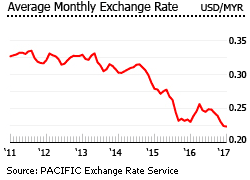
In Q3 2016, the country's GDP grew by 4.3% y-o-y. The expansion was attributed to the strong growth of private consumption expenditure (6.4% y-o-y growth), while fixed investment (2% y-o-y) and government consumption (3.1% y-o-y) had weaker gains, according to the Department of Statistics Malaysia. The increase of minimum wage (announced on July 1, 2016), partly aided in the surge of private consumption and domestic demand.
The IMF sees a 4.5% GDP growth for Malaysia in 2017 due to strong private consumption, but slower private investment and weak commodity prices.
Malaysia's economy expanded by almost 5% in 2015, although a slight slowdown from a robust growth of 6% in 2014. This followed years of economic gains of 4.7% in 2013, 5.5% in 2012, and 5.2% in 2011, according to the International Monetary Fund (IMF). From 2002 to 2008, economic growth averaged 5.7%, but growth fell sharply to 1.5% in 2009, during the global financial crisis. In 2010 GDP growth bounced back, surging by 7.5%.
Malaysia's nationwide inflation rate stood at 1.8% in December 2016, according to the Department of Statistics Malaysia, less than the 2.7% inflation rate in December 2015, as the impact from the Goods and Services Tax (GST) introduced in April 2015 has worn off.
In November 2016, the BNM retained its Overnight Policy Rate (OPR) at 3%, a few months after cutting it by 25 basis points in July 2016. The BNM's statement explained this:
"In Asia, persistent weakness in the external sector has weighed on growth, although domestic demand remains supportive. Looking ahead, there are increasing signs of moderating growth momentum in the major economies.
"Global growth prospects have also become more susceptible to increased downside risks in light of possible repercussions from the EU referendum in the United Kingdom."
The Malaysian ringgit (MYR) was one of Asia's worst-performing currencies in 2016, falling by more than 20% against the US dollar over the last two years. The situation worsened after Donald Trump's win in the US presidential elections, causing capital to flow back to the US, and leading to a 3.7% loss of ringgit's one-month non-deliverable forwards (NDFs) from the previous close to MYR 4.5395 per dollar on November 11, 2016, according to Thomson Reuters.
“The ringgit, like other emerging market currencies, has been badly hit by the anti-globalisation fears brought on by Donald Trump’s election and the US Fed’s accelerated plans for interest rate hikes," according to foreign exchange firm Oanda's senior trader, Stephen Innes.
“The ringgit’s problems also lie with the fact that the 1MDB scandal has not left the headlines despite a lot of rhetoric otherwise, and this is agitating global investors,” Innes added.
The 1MDB scandal is an ongoing political scandal about Malaysian Prime Minister Najib Tun Razak transferring around US$ 700 million to his personal account. The 1Malaysia Development Berhad (1MDB) is a strategic development company run by the Malaysian government. Set up in 2009, it aims at building strategic investments to boost the country.
The scandal gained attention in early 2015, as the reports of the company amassing a total of MYR 42 billion (approximately US$ 11 billion) worth of debt, and missing the payment of this debt to banks and bondholders, were revealed to the public. The Wall Street Journal exposed the channeling of US700 million from 1MDB to Prime Minister Najib on July 2, 2015, which was later denied by PM Najib.
Unemployment was 3.4% in November 2016, higher than the 3.2% unemployment rate in the same month last year, according to the Department of Statistics Malaysia.
Election spending scandal
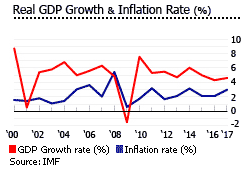
In the May 5, 2013 elections in Malaysia, the ruling Barisan Nasional (BN) coalition, dominated by Prime Minister Najib Razak’s party, United Malays National Organisation (UMNO), took over 60% of parliamentary seats, despite winning only 47.38% of the popular vote. The opposition Pakatan Rakyat (PR) coalition led by Anwar Ibrahim failed to win majority, even though it won 50.87% of the popular vote.
Anwar accused PM Razak and the Election Commission (EC) of electoral fraud. Recent investigations revealed that Razak spent US$700 million from an Arab donor to ensure that UMNO would remain in power during the 2013 elections.